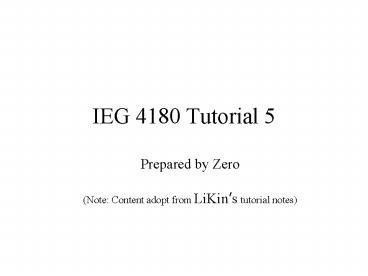IEG 4180 Tutorial 5 PowerPoint PPT Presentation
1 / 11
Title: IEG 4180 Tutorial 5
1
IEG 4180 Tutorial 5
- Prepared by Zero
- (Note Content adopt from LiKins tutorial notes)
2
Threads SynchronizationIntroduction
- Sharing data between threads may pose
synchronization problems - Data corruption
- Synchronize threads by
- Critical Section
- Kernel Objects
- Mutex
- Semaphore
3
Thread SynchronizationCritical Section
- A region of code that can only be accessed by one
thread only
4
Thread SynchronizationCritical Section An
Example
- Critical section can only synchronize threads
within the same process - Use kernel objects to synchronize between
processes - A critical section object will not be released
automatically if the holding thread is terminated
before calling LeaveCriticalSection()
5
Thread SynchronizationKernel Objects
- Kernel objects
- Data structures maintained internally by the OS
kernel - Can be used for inter-process synchronization
- e.g. Mutex, Semaphore, Socket, Timer,
- Difference between Mutex and Semaphore
- Mutex max. counter value 1
- At most one thread can own it
- Semaphore max. counter value N
- At most N threads can own it
6
Thread SynchronizationKernel Objects Object
State
- The counter
- Decrease by one when a thread claims it
- Increase by one when a thread releases it
- Always non-negative and not larger than the max.
value - Object state
- A kernel object is in signaled state when its
counter is larger than zero, otherwise it is in
non-signaled state - A thread can only claims signaled kernel objects
7
Thread SynchronizationCreating Mutex Semaphore
- Set bInitialOwner to true to claims the object as
soon as it is being created - lpName specify the name of Mutex / Semaphore,
which identify the kernel object across
difference processes - Semaphore
- lMaximumCount specify the max. counter value of
created semaphore - lInitialCount specify the initial counter value
of created semaphore
8
Thread SynchronizationClaiming Mutex Semaphore
- WaitForSingleObject
- Block until hHandle becomes signaled
- WaitForMultipleObjects
- bWaitAll true
- Block until all objects in lpHandles become
signaled - bWaitAll false
- Block until one object in lpHandles becomes
signaled
9
Thread SynchronizationCalling Sequence
10
Thread SynchronizationMutex Semaphore -
Examples
11
Thread SynchronizationExamples
- void main(void)
- HANDLE handlesnumThreads
- DWORD threadID
- INT i
- for (i0 iltnumThreads i)
- // create the threads
- handlesiCreateThread(0, 0, CountThread,
- NULL, 0, threadID)
- // wait for all threads to finish execution
- WaitForMultipleObjects(numThreads, handles, TRUE,
INFINITE) - cout ltlt "Global count " ltlt count ltlt endl

